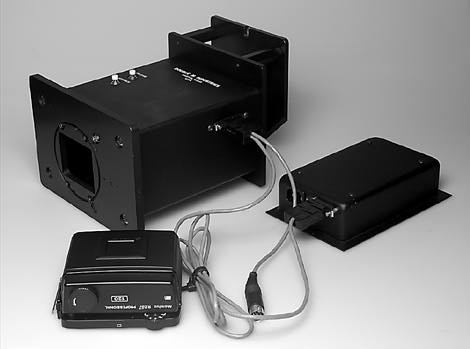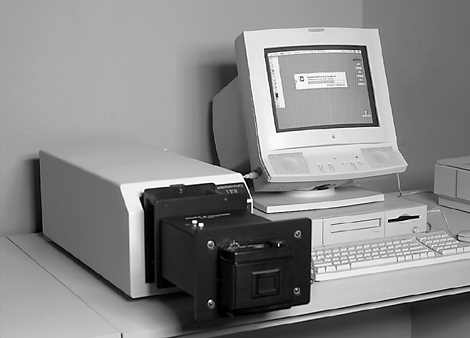

REMINISCENT of an old oscilloscope-camera rig, the Lasergraphics Film Recorder III will set you back rather more at around £25,000 ($40,000 - but we'll bet that it doesn't actually cost this in the States). Inside this device is one of the sharpest, brightest and fully corrected cathode ray tubes you can get, and a raster image memory which can hold a stable picture on the tube.
At the other end of the recorder is a mount with blanking plate. A range of different camera units, from a custom-built 35mm compact back with motordrive up to 8 x 10" cut film, can be slotted into this mount. There are no mechanical connections between the CRT system and the camera, just a small interface which accepts a 9-pin D-plug.
We tested the LFR III equipped with a Mamiya RZ67 rollfilm back and camera unit. The back is totally standard, unmodified; the camera unit contains a German repro lens and simple electronic time-exposure shutter. There is no provision for focusing, aperture or any other setting as the camera is adjusted and locked before delivery.
Inside the CRT unit, a set of high quality filters move into place mechanically to give sequential RGB exposure. This takes place fairly rapidly following the rasterizing of an image file sent to the recorder by a RASCOL driver program on the host computer. RASCOL is an industry standard raster-image recorder language, and there is no need to learn anything about it. Using a Macintosh, the whole business is totally plug and play; just attach the recorder via the SCSI interface, install the MacRASCOL Chooser-level printer driver, switch on and print. Windows set-up may be a little more long-winded but no more so than PC users are accustomed to.
With the interface box correctly wired up between camera and recorder - no instructions are given and it is possible to plug it in wrongly - everything is automatic including film advance after each exposure. Obviously there are limitations to automation using a standard 120/220 RZ67 back which offers only 10 or 20 exposures, and bureau users will opt for a 70mm back or a bulk 35mm device.

The LFR III offers 2K, 4K or 8K recording - the figures refer to the number of thousands of lines per inch recorded along the length of the image (not the height). Thus a 4K 35mm slide, the standard for high quality AV presentation, is written to film at an effective 2,836 pixels per inch - considerably finer that the 2,400 dots per inch which compose the lettering on the average imageset page.
Most ISO 100 slide films will resolve 100 line pairs per millimetre, equivalent to 200 pixels per mm, or 7,200 pixels on their longer dimension. The 8K resolution maximum of the LFR III is thus capable of exceeding the normal resolution of a 35mm slide, and by definition will produce a 6 x 7cm output similar in quality to an enlarged dupe from a 35mm frame. Technically, the resolution needed for sharp images on sheet film is not as high, which is why we donÕt use view camera lenses on 35mm cameras, and this means that 8K is considered adequate for all formats where normal enlargement up to 20 x 16" is required.
The file size for an RGB TIFF image at a 1:1 pixel ratio for this resolution of output would be 140 Mb. However, it is never necessary to use a file of this size, and results from 25Mb images intended for full-page printed reproduction are sharp enough for a similar sized print. The main benefit of recording at 8K rather than 4K is the absence of traces of the CRT scan-lines on the slide or negative.
This image is scanned from a 6 x 7cm dupe written on the LFR, working from a 9 Mb file (half-page magazine reproduction). While it lacks high-density detail it is sharp enough to be reprinted the same size without offending the eye. Most users will opt for files around 25 Mb in size to write 6 x 7cm film negs or slides. To compare it with a JPEG of the original file, click the picture.
To some degree, scan lines are lost through slightly unfocusing of the system. Do not expect grain-sharp results, because if you got them, you wouldnÕt like the artefacts which go with them. Writing a film recorder neg is rather like making a dupe using an enlarging lens rather than an ACT liquid-gate apochromatic optical bench.
Film recorders are available which image at 16K or 32K. However, to benefit from this larger image files are needed, commonly 256Mb as this is the largest size supported by many scanners and workstations.
RASCOL permits managed queues and batch processing, an ideal situation for bureaux. During the day, you can create your retouched files and AV slides. You print each one as it is complete, a very rapid process, but leave the queue on hold. At night, you load up a magazine, and release the print queue; the recorder will then run off how ever many copies of each file are specified. To do this you clearly need a 35mm or 70mm bulk back.
For smaller users, the LFR III can image and print each file as you finish it. The only drawback is that multiple copies involve repeated rasterization; the recorder can not hold all three channels in a buffer and run off several ÔprintsÕ in the way a PostScript laser printer can.
The speed and ease of use of the LFR III make it suitable for non-photographic personnel, even if loading an RZ67 back is an acquired skill. The menu when printing includes many popular film types including Provia 100 and Kodak Gold 100 negative, but our own tests using different films such as older Fujichrome 100 still produced perfect colour.
Teamed up with a Bray E-6 or C-41 processor the LFR III is an effective production unit. Bearing in mind that the charge for an 8K negative on 120 from a client image file is usually £40 to £50, and a typical Mac system with the LFR will manage half a dozen an hour including file loading and opening, the £25,000 investment is not high for returns. But prices will have to fall.
The negative can save a fortune later, as ordinary photo prints costing as little as £5 for a 20 x 16 MCP can be run off. Try buying a 20 x 16 digital print and see that figure rise to around £200 - if you can find anything better than a crude bubble-jet printout.
Education is vital here. Many photographers, unaware of the quality of filmwriter negs, order a dye sub print and then copy it to make future reprints. There is a huge difference in quality; the LFR III controls tonal range so well that every nuance of shadow detail, often totally lost in a dye sub or Pictrography print, is revealed.
While the LFR III is a specialized device, not something the average reader will buy, it is affordable for labs and bureaux and its speed should enable 6 x 7cm slides or negs to be written for prices around £15-25 at the desirable 8K resolution from files which can fit on a 44Mb SyQuest. One lab in Britain, Colorworld, is already offering £15 ($25) rollfilm negatives from retouched work.
Such negatives are ideal for reprints of retouched wedding and portrait pictures, industrial and commercial compositions, and restored oldies. Bringing average prices down from £50-150 to this level will bring digital image possibilies to thousands of smaller studios and freelance operators who are worried about dropping behind but equally concerned about the price traps cunningly built-in to the new technology.
Any competent imaging lab can have the LFR III up and running within an hour of delivery.
The Lasergraphics range of film recorders includes several lower-cost models limited either in resolution or format. They are imported to the UK by IMC of Windsor, and manufactured in the USA by Lasergraphics Inc, 20 Ada, Irvine, CA 92718.